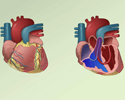Double aortic arch
Aortic arch anomaly; Double arch; Congenital heart defect - double aortic arch; Birth defect heart - double aortic arch
Double aortic arch is an abnormal formation of the aorta, the large artery that carries blood from the heart to the rest of the body. It is a congenital problem, which means that it is present at birth.

Causes
Double aortic arch is a common form of a group of defects that affect the development of the aorta in the womb. These defects cause an abnormal formation called a vascular ring (a circle of blood vessels).
Normally, the aorta develops from one of several curved pieces of tissue (arches). As babies develop in the womb, the arches split into several parts. The body breaks down some of the arches, while others form into arteries. A normally developed aorta is a single arch that leaves the heart and moves leftward.
In double aortic arch, some of the arches that should have disappeared are still present at birth in addition to the normal arch. Babies with a double aortic arch have an aorta that is made up of two vessels instead of one. The two parts to the aorta have smaller arteries branching off of them. As a result, the two branches go around and press down on the windpipe and the tube (esophagus) that carries food from the mouth to the stomach.
A double aortic arch may occur in other congenital heart defects, including:
Double aortic arch is very rare. Vascular rings make up a small percentage of all congenital heart problems. Of these, a little more than half are caused by double aortic arch. The condition occurs equally in males and females. It is often present in people with certain chromosome abnormalities.
Symptoms
Because symptoms of double aortic arch are often mild, the problem may not be discovered until the child is a few years old.
The double aortic arch may press on the trachea and esophagus, leading to trouble breathing and swallowing. The severity of the symptoms depends on how much the aortic arch is pressing on these structures.
Breathing symptoms include:
- High-pitched sound during breathing (stridor)
- Noisy breathing
- Repeated pneumonias
- Wheezing
Digestive symptoms may include:
- Choking
- Difficulty eating and swallowing
- Vomiting
Exams and Tests
The symptoms may lead a health care provider to suspect double aortic arch. Other tests will then be needed to confirm the diagnosis.
The following tests can help diagnose double aortic arch:
- Chest x-ray
- Computed tomography (CT) scan of the heart and major blood vessels
- Camera down the throat to examine the airways (bronchoscopy)
- Magnetic resonance imaging (MRI) of the heart and major blood vessels
- Ultrasound examination (echocardiogram) of heart
- X-ray of blood vessels (angiography)
- X-ray using a substance that outlines the esophagus (barium swallow)
Treatment
Surgery can be done to fix double aortic arch. The surgeon ties off the smaller branch and separates it from the larger branch. Then the surgeon closes the ends of the aorta with stitches. This relieves pressure on the esophagus and windpipe.
Outlook (Prognosis)
Most children feel better right after surgery, although some may continue to have breathing symptoms for some time after surgical repair. This is most often due to weakness of the trachea because of the pressure on it before surgical repair.
In rare cases, if the arch is pressing down very hard on the airway, the child can have severe breathing difficulty that leads to death.
Possible Complications
Complications may include:
- Failure to thrive
- Respiratory infections
- Wearing away of the lining of the esophagus (esophageal erosion) and windpipe
- Very rarely, an abnormal connection between the esophagus and aorta (aortoesophageal fistula)
When to Contact a Medical Professional
Contact your provider if your infant has symptoms of double aortic arch.
Prevention
There is no known way to prevent this condition.
References
Bernstein D. General principles of treatment of congenital heart disease. In: Kliegman RM, St. Geme JW, Blum NJ, et al, eds. Nelson Textbook of Pediatrics. 22nd ed. Philadelphia, PA: Elsevier; 2025:chap 483.
Bryant R, Yoo S-J. Vascular rings, pulmonary arterial sling, and related conditions. In: Wernovsky G, Anderson RH, Kumar K, Mussatto K, et al, eds. Anderson's Pediatric Cardiology. 4th ed. Philadelphia, PA: Elsevier; 2020:chap 47.
Kliegman RM, St. Geme JW, Blum NJ, et al. Other congenital heart and vascular malformations. In: Kliegman RM, St. Geme JW, Blum NJ, et al, eds. Nelson Textbook of Pediatrics. 22nd ed. Philadelphia, PA: Elsevier; 2025:chap 481.
Valente AM, Dorfman AL, Babu-Narayan SV, Krieger EV. Congenital heart disease in the adolescent and adult. In: Libby P, Bonow RO, Mann DL, Tomaselli GF, Bhatt DL, Solomon SD, eds. Braunwald's Heart Disease: A Textbook of Cardiovascular Medicine. 12th ed. Philadelphia, PA: Elsevier; 2022:chap 82.
Well A, Fraser CD. Congenital heart disease. In: Townsend CM Jr, Beauchamp RD, Evers BM, Mattox KL, eds. Sabiston Textbook of Surgery. 21st ed. St Louis, MO: Elsevier; 2022:chap 59.
Review Date: 2/27/2024








